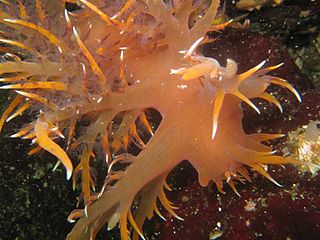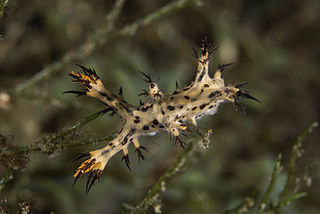
Dendronotidae is a family of sea slugs, nudibranchs, marine gastropod mollusks in the superfamily Dendronotoidea. This family is within the clade Cladobranchia.
Kikutaro Baba was a Japanese malacologist. He was the leading researcher on sea slugs and bubble snails, opisthobranch gastropod mollusks in Japan.

Dendronotus is a genus of sea slugs, nudibranchs, marine gastropod molluscs in the superfamily Tritonioidea.

Verconia purpurea is a species of colourful sea slug, a dorid nudibranch, a shell-less marine gastropod mollusk in the family Chromodorididae. It was first described in 1949 by Kikutaro Baba as Noumea purpurea.
Crimora lutea is a species of sea slug, a nudibranch, a shell-less marine gastropod mollusc in the family Polyceridae.

Goniodoris felis is a species of sea slug, a dorid nudibranch, a marine gastropod mollusc in the family Goniodorididae.

Okenia echinata is a species of sea slug, specifically a dorid nudibranch, a marine gastropod mollusc in the family Goniodorididae.

Trinchesia anulata is a species of sea slug, an aeolid nudibranch, a marine gastropod mollusc in the family Trinchesiidae.
Trinchesia akibai is a species of sea slug, an aeolid nudibranch, a marine gastropod mollusc in the family Trinchesiidae.
Tenellia pinnifera is a species of sea slug, an aeolid nudibranch, a marine gastropod mollusc in the family Fionidae.

Dermatobranchus albopunctulatus is a species of sea slug, a nudibranch, a marine gastropod mollusc in the family Arminidae.

Dermatobranchus nigropunctatus is a species of sea slug, a nudibranch, a marine gastropod mollusc in the family Arminidae.

Dermatobranchus striatellus is a species of sea slug, a nudibranch, a marine gastropod mollusc in the family Arminidae.
Cabangus noahi is a species of sea slug, a dendronotid nudibranch, a shell-less marine gastropod mollusc in the family Dendronotidae.

Cabangus regius is a species of sea slug, a dendronotid nudibranch, a shell-less marine gastropod mollusc in the family Dendronotidae.

Pseudobornella orientalis is a species of sea slug, a dendronotid nudibranch, a shell-less marine gastropod mollusc in the family Dendronotidae.

Polycera japonica is a species of sea slug, a nudibranch, a shell-less marine gastropod mollusc in the family Polyceridae.

Cratena affinis is a species of sea slug, an aeolid nudibranch, a marine gastropod mollusc in the family Facelinidae.

Phidiana anulifera is a species of sea slug, a nudibranch, a marine, gastropod mollusc in the family Facelinidae.
Paratritonia is a genus of sea slugs, specifically dendronotid nudibranchs. It is a marine gastropod mollusc in the family Tritoniidae.













